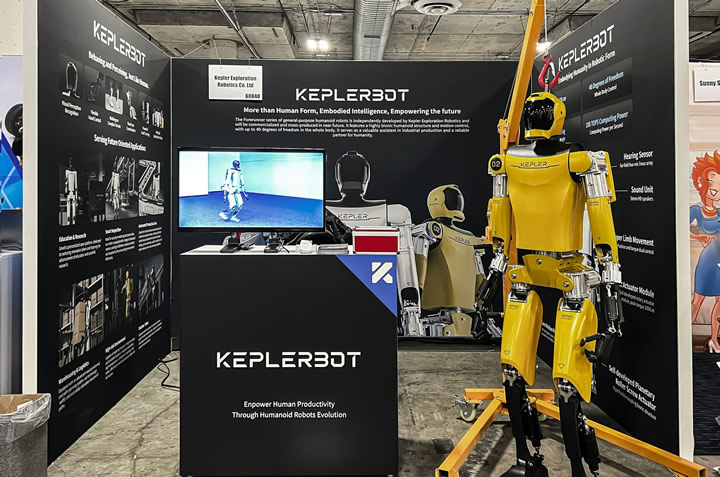CES 2024 Spotlight: Kepler's Humanoid Robot Launch Gains International Recognition

Kepler Exploration Robot Co., Ltd. ("Kepler") unveiled its groundbreaking Kepler Forerunner series of general-purpose humanoid robots ("Kepler Humanoid Robot") at the 2024 Consumer Electronics Show (CES) in Las Vegas. The event, which took place from January 9-12, was notable for its substantial Chinese representation, with over 1,100 Chinese companies among the 4,000+ exhibitors, accounting for an impressive 25% of all participants.
The showcase marked Kepler's first participation in a major global exhibition following the official launch of its humanoid robots. The Kepler Humanoid Robot garnered immediate attention from numerous professional visitors at the event, including several of the industry's most respected experts.
The Kepler Humanoid Robot Garners Significant Industry Interest with Impressive Debut
At the forefront of technological innovation, the newly founded Kepler, just four months into its journey, captured the attention of industry insiders and media at the exhibition for its humanoid robots, a testament to the company's robust research and development capabilities and its commitment to innovation.
The Kepler exhibit attracted a parade of high-profile visitors, among them, Microsoft's CEO Satya Nadella, the Vice President of Microsoft's Windows and Devices, the head of Nvidia's project management and ecosystem, representatives from Australian TV networks, the team from Canadian humanoid robotics firm Sanctuary AI, engineers from Tesla's Optimus project, experts from Google DeepMind, and a delegation of MIT researchers. Debo Hu, Co-founder and Vice President of Kepler, personally introduced the line-up of guests to the Kepler Humanoid Robot. During the CES Showstopper media event, the robots captivated the attention of several international journalists.
Kepler is progressively localizing the production of its proprietary humanoid robots, with only a few components such as the robot's motherboard still being sourced abroad. Plans are underway to transition these parts to domestic suppliers. In an interview, Mr. Hu highlighted Kepler's success in overcoming supply chain challenges through its substantial in-house research capabilities, aiding in both product development and cost efficiency.
Focusing on In-House Development to Build Core Competitiveness in Humanoid Robotics
Keplers' Forerunner series, unveiled at this year's CES, is a showcase of the company's advanced technologies in humanoid robots. The series, featuring Kepler's proprietary planetary roller screw actuator, its intelligent dexterous hand, and the NEBULA system, is designed for versatility across multiple application scenarios and collaborative platforms.
The series consists of three distinct models: K1, S1 and D1, each standing at a height of 178cm (5'10") and weighing 85kg (187 lbs.). Besides reducing costs and increasing efficiency, Kepler's proprietary planetary roller screw and rotary actuators are key to the dynamic movement of the Forerunner humanoid robot's limbs. This allows for an enhanced maximum load capacity for each component and enables the simulation of human muscle movement control with exceptional precision. The dexterous hand, considered as one of the most challenging components of a humanoid robot, is a Kepler innovation with 12 degrees of freedom, adeptly balancing load capacity and control accuracy.
The software that forms the backbone of Kepler's proprietary NEBULA system enables the robot to interact with the surrounding environment in real time, addressing challenges in visual, auditory and sensory perception. By integrating a motherboard with a processor providing 100 TOPS of computing performance into the NEBULA system, the actuator boasts four primary functions: visual recognition, visual SLAM (Simultaneous Localization and Mapping), multimodal interaction, and hand-eye coordination. Furthermore, Kepler has equipped the humanoid robot with a cloud-based multimodal large model while simultaneously deploying a smaller, industry-specific model on the robot itself for quicker response times.
Kepler Leads the Industry by Achieving Mass Production and Enhancing Productivity Through Multi-Scenario Applications
The Kepler Humanoid Robot, designed for multifunctional use, is adept at operating in various settings, including education and research, automated production lines, intelligent material handling, complex environment inspections, emergency rescue services, outdoor safety operations, and detection of concealed safety hazards. Additionally, Kepler provides customized robots tailored to customer needs, allowing for an even broader range of applications.
The Kepler co-founder, Mr. Hu, explained that the Kepler Forerunner series is equipped with a power system that employs planetary roller screw actuator and rotary actuator technology, enabling the robots to rival global competitors in full-body mobility, manual dexterity, hand-eye coordination, and visual perception and recognition capabilities. Kepler anticipates commencing mass production of its humanoid robots in the second half of 2024, with an estimated retail price range of US$20,000 to US$30,000, positioning the company at the forefront of the industry.
Mr. Hu pointed out that the worldwide humanoid robot market has reached a pivotal moment for commercialization, with a few players beginning to launch their products into the market. He emphasized the importance of collaboration and co-creation in driving technology advancement. The ethos underpinned Kepler's participation in CES, showcasing their advancements to industry peers worldwide. In addition, the firm has introduced the Kepler OS, a global developer platform that provides comprehensive development interfaces, reference projects, and extensive documentation. The platform facilitates coordination between multiple robots and offers robust online development and debugging capabilities.
Looking ahead, Kepler aims to collaborate with global developers on the Kepler OS platform to further the intelligent development of research and industry applications, contributing to the growth of the global humanoid robot market.
Comments (0)
This post does not have any comments. Be the first to leave a comment below.
Featured Product

